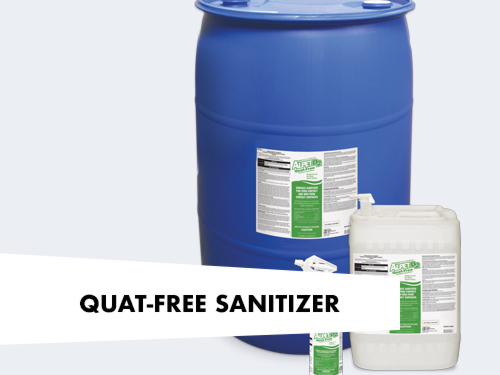Quat Free vs. Quat Based Sanitizers
Written by Adam Serfas

Sanitizers are important in a food-safe facility for eliminating the risk of contamination and food-borne illness. If you run a food-safe facility, chances are you’ve come across quat and quat-free sanitizers. Here’s a guide that breaks down the difference and exactly what you need to know about using these sanitizers.
Sanitizing Procedures
Disinfecting and sanitizing are two separate procedures. To disinfect a surface means that all microscopic organisms listed on the label (i.e. bacteria and fungi) will be killed. Sanitizing reduces the number of harmful microorganisms to a number considered to be within safety standards. Generally, sanitizing involves a cycle of cleaning, rinsing and then sanitizing the surface.
Definition: Quat Sanitizers
Let’s start with the basics, what is quat? Quat is the common name for quaternary ammonium chloride compounds. The compounds contain four organic groups - hence the quaternary part of the name. There are around 300 different kinds of quat sanitizers that each have varying degrees of anti-microbial effectiveness meaning they can kill address a broad microbial range. Essentially, sanitizers with quat as an active ingredient pack strong cleaning power without being highly toxic and corrosive like a bleach. They are also preferred due to the fact that they are odorless, non-staining and tend to have a long shelf life.
Definition: Quat-Free Sanitizers
Sanitizers billed as quat-free sanitizers, are generally also alcohol-based cleaners; however, have a key difference in terms of what is left over once the alcohol evaporates. When you use quat sanitizers, the alcohol in the solution will eventually evaporate but it will leave behind a the quaternary ammonia as a residual that continues to work on germicidal degradation on the surface. In a home setting, eventually the quaternary ammonia would break down and eventually evaporate as well, but in a food processing environment, it almost never happens as things are generally getting sprayed down multiple times in a day. Quat-free sanitizers leave behind no residual.
Residuals Left Behind: Does It Matter For Your Facility?
Most of the time, it’s not a big deal for food processors to have some residuals from sanitizers left behind. That being said, there are some specific scenarios where this can present a problem.
- Producers That Deal With Yeast
Generally facilities with a yeast fermentation process - bakeries, breweries, wineries tend to care the most about this as the ammonia residuals from a regular surface sanitizer can slow down the fermentation process and, most notably, can potentially affect product taste.
- Dairies
Most dairies will also avoid using quat sanitizers in their facilities as doing so could inadvertently inactivate the live cultures needed to produce products such as cheese and yogurt.
- Dry Processors
Dry processors that need to control moisture in their facility tend to use quat-free sanitizers because it evaporates very quickly on surfaces.
- Processors With Water Sensitive Equipment
Those that need to sanitize water sensitive equipment will want to use quat-free sanitizers as well for the same reason that dry processors would: it doesn’t contain a high percentage of water will evaporate quickly.
- Processors Exporting to the EU
The European Union mandates a very low maximum residue level for quaternary ammonium. Processors exporting to the EU often want to use quat-free sanitizers to ensure they are able to remain below that legal limit.
At R.S. Quality Products, we carry Best Sanitizer’s Quat and Quat-Free Sanitizers.
Should you have any questions about which is right for your sanitizing needs, we
encourage you to contact us.


